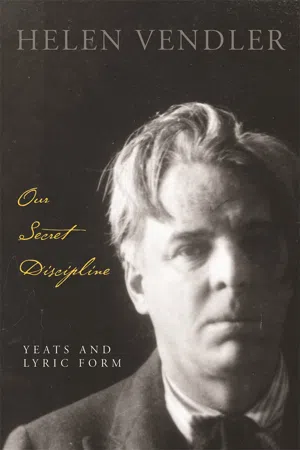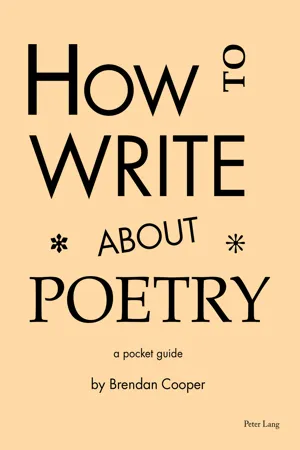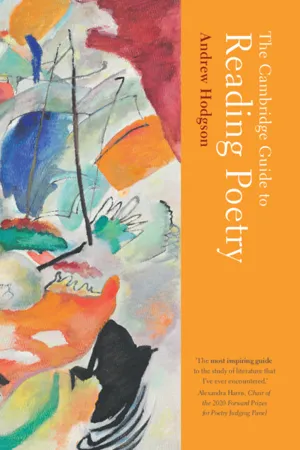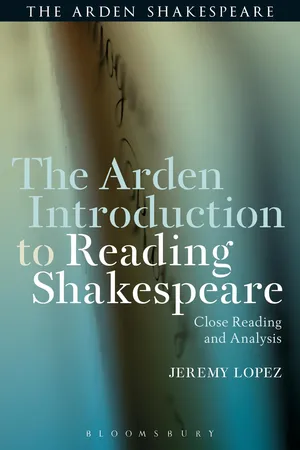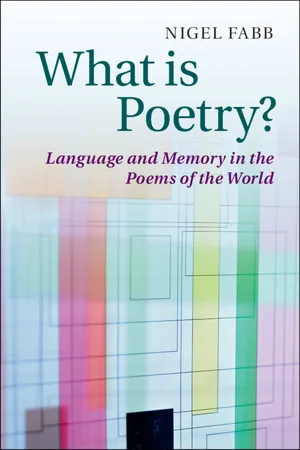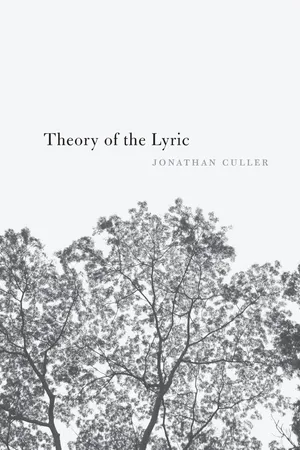Literature
Tetrameter
Tetrameter is a poetic meter consisting of four metrical feet per line. Each foot typically contains two syllables, resulting in a total of eight syllables per line. This rhythmic pattern is commonly found in various forms of poetry, including ballads, hymns, and narrative verse. Tetrameter is known for its regular and structured rhythm, which contributes to the overall musicality of the poem.
Written by Perlego with AI-assistance
12 Key excerpts on "Tetrameter"
- eBook - ePub
- Eric Weiskott(Author)
- 2021(Publication Date)
- University of Pennsylvania Press(Publisher)
mismeter and the reference to missing syllables, but also how meter and phonology could appear to him as poetic problems in the first place. Cole confirms a single basic metrical phonology connecting alliterative meter, Tetrameter, and pentameter, across lines of dialect, geography, and authorship, in the closing decades of the fourteenth century. This surprising situation, which I will argue was partly Chaucer’s doing, needs to be seen in verse-historical context.The Tetrameter entered the English literary field in the late twelfth or thirteenth century under influence from French octosyllables and Latin accentualsyllabic Tetrameter (see Chapter 4 ). By the time Chaucer set out to compose what is probably his earliest extant long poem, the Book of the Duchess (late 1360s/1370s), the Age of Tetrameter was well under way, and Tetrameter was the readiest alternative to the alliterative meter. Chaucer’s exclusive preference for Tetrameter for long poems before the Parliament of Fowls and Troilus and Criseyde has attracted remarkably little critical scrutiny.4 Yet that preference speaks volumes. Chaucer and Langland made opposite metrical choices in the 1360s, a consequence of their divergent social and geographical trajectories. Chaucer’s decision was, in part, expedient. Translating the Roman de la rose during or before work on the Book of the Duchess, Chaucer reached for the English equivalent of French octosyllables.The metrical phonology of Tetrameter reflects its medium-length history. Many twelfthand thirteenth-century word forms appeared in fourteenth-century Tetrameter. These phantom syllables no longer functioned in everyday speech and may not have been pronounced in performance, but they contributed to metrical structure as they always had. Similar phenomena, however counterintuitive, are attested in many other long-lived metrical traditions, including Ancient Greek quantitative verse, English alliterative verse, Norse alliterative verse, and modern French and Portuguese syllabic verse.5 Metrical history shapes poets’ and readers’ phenomenological experience of metrical phonology. In Chaucer’s Tetrameter, historical word forms stand in free variation with contemporary spoken forms. Compare, for example, Book of the Duchess 34 Myselven can not telle why (xSxSxSxS) and 598 Allas! and I wol tel the why (xSxSxSxS). In the first line, the infinitive verb telle counts an inflectional -e. In the second line, the -e is discounted in scansion and, as it happens, omitted in spelling. Only the first scansion, with metrically significant inflectional -e, was permissible in fourteenth-century alliterative verse apart from Piers Plowman. And so on through various classes of historical -e: the vocalic endings of Latin, Old English, Old French, and Old Norse nouns; analogical -e in historically feminine nouns; and the inflections of imperative verbs, weak and/or plural adjectives, and the preterite singular of Old English weak verbs of class I. In each case, alliterative poets cleaved to historical phonology while Chaucer and other poets writing in Tetrameter (and Langland: see Chapter 7 - Most often, as in the Milton passage, it is an occasional device of variation. However, whole poems have sometimes been composed in mixed metre (see the example quoted in section 4.9 below). By far the most common trochaic line is the trochaic Tetrameter, the four-foot line in falling rhythm. However, it is important to register here that poets working in this metre very often drop the final unstressed syllable of the line (as in the majority of the lines in the Dyer passage and as in the Robinson stanza, where complete and curtailed lines alternate). Here the catalectic line comes into its own, almost to the point where it becomes the norm. This is somewhat confusing to the reader of poetry who expects to see orthodoxy in the frame. Take Blake’s (1757–1827) famous ‘The Tyger’, which is in trochaic Tetrameters though it possesses several iambic lines: / x / x / x / Tyger, | tyger, | burning | bright / x / x / x / In the | forests | of the | night / x / x / x / What immortal hand or eye x / x / x / x / Could frame thy fearful symmetry? Only the fourth line is complete; the other lines in the stanza are curtailed and end on the fourth stressed syllable. This truncation is very frequent in the trochaic Tetrameter, almost to the point where many poems written in this metre resemble seven-syllable ‘heptasyllabics’. This fact, added to the frequent use of trochaic substitution at the start of iambic lines (which themselves end in a stressed syllable), does not make the identification of trochaic metre easy. However, if one bears in mind our point about the tendency to use catalectic final feet in trochaic metre, then the picture begins to clarify. Generalising about particular metrical forms is not without its attendant 92 Poetry hazards. Against every attempt to make overarching statements about the qualities of a given metre, many examples of lines which contradict such assertions might be found.
- eBook - PDF
Our Secret Discipline
Yeats and Lyric Form
- Helen Vendler(Author)
- 2007(Publication Date)
- Belknap Press(Publisher)
VIII i Marches and the Examination of Conscience: The Tetrameter Line The four-beat line, appearing without an intermixture of lines of dif-fering length, occurs early in Yeats. Some of its first manifestations—faint and wavering rhythms of Paterian impressionism, and Swinburnian dance-rhythms with heady alliteration—did not prove lasting. But other versions of the Tetrameter—iambic, trochaic, or a mixture of these two rhythms— appeared in Yeats’s poems for years. The line, intermediate in length be-tween the rapid trimeter and the ceremonious pentameter, proved adapt-able to many rhyme-units and to stanzas of different lengths. The number of Yeats’s Tetrameter poems precludes offering a complete list of them, as one can for his sonnets, trimeter quatrains, blank verse, and ottava rima po-ems. The central examples I take up in this chapter will, I hope, justify my title; Yeats’s Tetrameters can be used sternly or decisively or interrogatively, but also musically, gently, and epigrammatically. There is very little they cannot do. Yeats used the Tetrameter line in any number of stanza forms. He shapes it, for instance, into couplets in both “Under Ben Bulben” and “The Man and the Echo,” but to very different rhythmic effect. In “Under Ben Bulben,” after some commanding initial trochees, the couplets (aa) become predominantly iambic: Under bare Ben Bulben’s head In Drumcliff churchyard Yeats is laid, An ancestor was rector there Long years ago; a church stands near[.] (640) By contrast, in “The Man and the Echo” incisive and insistent trochaic cou-plets predominate: 205 Did that play of mine send out Certain men the English shot? (632) The Tetrameter line can also be used to create attractive quatrain-forms. In his elegy for the Gore-Booth sisters, Yeats shapes the line into embraced quatrains, abba (the “In Memoriam” stanza): The light of evening, Lissadell, Great windows open to the south, Two girls in silk kimonos, both Beautiful, one a gazelle. - Mick Short(Author)
- 2018(Publication Date)
- Routledge(Publisher)
Now let us restrict our discussion for a moment to lines of poetry with iambic ·('di dum') feet. Normally, iambic lines will consist of more than one iamb, and poets can choose how 132 Exploring the language of poems, plays and prose many iambs to have as the basic line-template for particular poems. One particular form has dominated English poetry since the fifteenth-century, however, namely a line with five iambs, as in the following example: Example 2 X I X I X I X I X I Then tooke the angrie witch her golden cup X I X I X I X IX I Which still she bore, replete with magick artes; (Edmund Spenser, The Faerie Queene, I, viii, 14) This kind of line is found throughout the verse of Shakespeare, Milton and Wordsworth, for example, and is called iambic pentameter (literally 'iambic five metre'). We might call the iambic pentameter line the metrical norm for English poetry from the fifteenth-century onwards. Other possibilities can, of course, be found: 1. Manometer 2. Dimeter 3. Trimeter 4. Tetrameter 5. Pentameter 6. Hexameter one foot line two feet lines three feet lines four feet lines five feet lines six feet lines These 'number of feet' combinations can in principle involve any kind of foot as the basic unit, and various stanza forms can have patterns involving differing numbers of feet from line to line (for example, Keats's 'Song', which we analysed in 2.2. 7, has Tetrameters in the first and third lines of each verse and trimeters in the second and fourth lines). But it is the iamb in units of five which is the dominant English verse form. Exercise 1 (a) Re-examine Keats's 'Song' in 2.2.7. What is the rhythmical effect created by having a 'missing foot' in the second and fourth lines? (b) Below are a series of extracts from poems. Work out, for each example, what the basic foot unit is and how many feet there are to the line.- eBook - PDF
How to Write About Poetry
A Pocket Guide
- Brendan Cooper(Author)
- 2019(Publication Date)
Chaucer’s lines are in iambic pentameter – five iambs in each line, and so ten syl- lables in total. Over the centuries this remained the most popular manifestation of iambic metre in English, but iambic line lengths can vary: iambic Tetrameter is eight- syllable lines (four iambs), iambic trimeter is six-syllable lines (three iambs). Lines longer or shorter than these do sometimes crop up, but they are pretty rare. What, though, is the effect of writing in such a metre? What makes it significantly distinct from the natural rhythms of prose? This is not an easy question – and part of the answer, for poets across the centuries, will have been 44 Chapter 3 connected more to convention than to a conscious desire to create a particular effect. To some extent, the use of a regu- lar metre in poetry is a signal that the writing is poetry – written in verse, and not in prose. A little like with rhyme, though, the basic effect of using a regular metre in poetry is the creation of harmony. Let us go back to “She Walks in Beauty” by Byron: She walks in beauty, like the night Of cloudless climes and starry skies Byron is basing his metre here, quite clearly, on iambic Tetrameter: eight-syllable lines of alternate stresses. The regularity of this metre seems to fit with the beauty of the woman he describes, and the unity of elements of dark and bright that he notes in her appearance. We might say, in other words, that the regular nature of the metre fits with the tone and the content of what the poem describes. Having said this, the idea of metre as a harmonising force has quite serious limitations. Are all poems written in iambic metre about something harmonious? The answer, of course, is no. Moreover, any effort to write a purely iambic poem, with absolutely no variation at all, is likely to lead to something very monotonous and dull. Most poems, even if they are based in, say, iambic metre, are not consistently iambic all the way through. - eBook - ePub
- Geoffrey N. Leech(Author)
- 2014(Publication Date)
- Routledge(Publisher)
14 we may observe that silent stresses normally intrude themselves at the end of lines with an odd number of accents, but not at the end of those with an even number. Trimeters and pentameters, for example, have a silent stress, but not Tetrameters. If, therefore, we add the silent stress on to the number of vocalized stresses in each line, we reach the conclusion that all metres, even those apparently odd, are actually based on an even number of stresses per line. A pentameter can be regarded as a hexameter with one stress silent, and so on. The double measure (corresponding to the traditional ‘dipode’) is a basic unit of metre.To test this, read through the following extracts, and note how a pause seems to be required between trimeters or between pentameters, but not between dimeters or between Tetrameters. Again, tapping in time with the stressed syllables may aid the perception of silent stresses.Recognizing the existence of silent stresses can help us to appreciate further connections between verse and music. Just as the simpler song and dance forms of music tend to break down into four-bar, eight-bar, and sixteen-bar sections, so many verse forms are constructed out of the basic rhythm units by multiples of two. Each of the three popular metrical patterns set out below has the symmetrical structure of a square, being composed of four sections of four measures each. These sections do not in every case correspond to verse lines, which are separately indicated (by the symbol 1 ):If, as I hope, the reader has been able to decipher these formulae without too much difficulty, they may well be recognized as [a] the metre of Old Mother Hubbard, [b] the limerick metre, and [c] the popular ballad metre of The Ancient Mariner and many other poems. This way of displaying the metrical pattern shows a regularity obscured by the normal line-by-line arrangement. In more sophisticated stanza forms, this mathematical symmetry of pattern is generally less marked, but it may be part of the set of expectations we bring to English verse.Whilst on the subject of duality, we may notice that there is a curious ambivalence between single measures and double measures, which is parallel to the ambivalence of two-time and four-time in musical time-signatures. It is easy to interpret the same piece of poetry as consisting of either two measures of two syllables, or one measure of four syllables; which interpretation suggests itself most strongly is largely controlled by the speed of delivery. Kipling’s four-syllable (pæonic) metre, as we saw earlier, requires recitation at a rather fast, cantering speed: - eBook - PDF
- Andrew Hodgson(Author)
- 2021(Publication Date)
- Cambridge University Press(Publisher)
[BEAT] We hear that the trimeters are a beat shorter than the Tetrameters, and we count that beat in at the end of the line for balance. The prevalence of the four-beat pattern means that it is rare to read heptameter lines without hearing how they might resolve themselves into this 4 – 3 – 4 – 3 sequence, too. At the end of each heptameter line of Felicia Hemans’s ‘The Indian 80 Reading a Poem Woman’s Death Song’ (1828), for instance, we can hear a similar missing beat that would balance out the stresses either side of the caesura: She bears thee to the glorious bowers || where none are heard to weep, [BEAT] And where th’ unkind one hath no power || again to trouble sleep; [BEAT] And where the soul shall find its youth, || as wakening from a dream, – [BEAT] One moment, and that realm is ours. – || On, on, dark rolling stream! [BEAT] But though the movement is similar to the form Wheatley adopts, the impact is different. The seven-foot line, where a caesura and not a line ending marks the renewal of the four-beat count, flows with a momentum sympathetic to the longing for oblivion that Hemans’s singer expresses. The different ways in which the heptameters, Tetrameters, trimeters, and monometers above thread themselves around the four-beat sequence indi- cates why we need the separate metrical terms to describe them. Acquiring the technical language of metre is less important than devel- oping an ear for the actual rhythms of a poem: rhythm is real; metre is the abstract ideal that underpins it. Yet having the technical vocabulary to hand can sharpen our attention to what we hear. Let’s try to determine the metre of the following lines in tribute to her husband, by Anne Bradstreet (1678): My head, my heart, mine eyes, my life, nay more, My joy, my magazine of earthly store, If two be one, as surely thou and I, How stayest thou there, whilst I at Ipswich lie? We’ll begin on this occasion with the patterns of emphasis, rather than the number of beats. - eBook - PDF
The Arden Introduction to Reading Shakespeare
Close Reading and Analysis
- Jeremy Lopez(Author)
- 2018(Publication Date)
- The Arden Shakespeare(Publisher)
PART FOUR Overview The language of Shakespeare’s plays and poems is, for the most part, metrical language. It is written according to formal conventions that depend on more or less precise units of measurement: the line, usually composed of ten syllables; the word, which must be chosen not only for its expressive power but also with an eye to its relation to the length of the line; and the individual syllable, which, as will be discussed below, must be placed in a particular rhythmic relationship to every other syllable. Parsing the metre of a Shakespearean poetic line – the process is called ‘scansion’ – and describing or analysing the effects of metre is easier to do in the classroom than by means of a book. It is both a highly technical activity, where nearly every rule has an exception, and an activity that benefits greatly from reading the poetry aloud and, more importantly, hearing it read aloud by an experienced reader. This chapter, then, can give only the barest of introductions to Shakespeare’s metre. It will do so by focusing on the sonnets, which, because they do not need to be located within a larger expository context, provide a more controlled environment for the detailed analysis of metre; the analysis I model can, nevertheless, be applied to most of Shakespeare’s dramatic poetry. The aim of the chapter will be to show how Shakespeare writes lines that correspond to the rhythms of ordinary speech, even as they maintain a formal rigour that distinguishes them as poetry. Much as his skill as a dramatist lies in his ability to observe, CHAPTER THIRTEEN Metre THE ARDEN INTRODUCTION TO READING SHAKESPEARE 142 and yet to treat as permeable, the boundaries between one act or scene and another, so Shakespeare’s skill as a poet lies in his ability to work within, and yet to treat as flexible, the poetic conventions he inherited. In this chapter I will use two sonnets, 129 and 130, to introduce you to, and help you to begin to analyse, Shakespeare’s metre. - eBook - PDF
What is Poetry?
Language and Memory in the Poems of the World
- Nigel Fabb(Author)
- 2015(Publication Date)
- Cambridge University Press(Publisher)
4 Metre This chapter illustrates various traditions of metrical poetry, grouped into types of metre. The fundamental goal is to demonstrate that the section of text controlled by the metre is always sufficiently small that it can fit into working memory. Metre Keats’s sonnet on Homer has the added form of metre, and specifically the metre called iambic pentameter. This metre controls number and rhythm, and holds of the line as a distinct section of text. It fairly strictly controls the number of syllables in the line (ten) and slightly more loosely controls the rhythm of the line (even-numbered syllables tend to be stressed). Here is one line from the sonnet: Yet did I never breathe its pure serene σ σ σ σ́ σ σ́ σ σ́ σ σ́ It has ten syllables, and the fourth, sixth, eighth and tenth syllables must be stressed in all performances (because of the category and shape of the words involved), while stressing on the first three syllables depends on the performer. I have written ‘σ’ under each syllable, and indicated with an accent those syllables that must be stressed (lexical monosyllables, and the main stressed syllable in a polysyllable). All metres count units, and most metres also control rhythm. Sometimes the rhythm is based on stress, as here, and sometimes on syllable weight or syllable tone. The metrical rhythm is always based on the patterning of just two kinds of syllable, as noted by Lotz (1960: 140): ‘the phonological elem- ents are grouped into two base classes, never into more’. We saw in Chapter 1 that the lines of Homer’s Odyssey are in a rhythm based on patterns of weight. A bar below a syllable indicates that it is heavy, and a curve that it is light; syllables are grouped either as heavy–heavy or as heavy–light–light, and there are six groups in the line. 72 plagchthee, epei Troiees hieron ptoliethron epersen: j – j – –j– : j– j– j– –j In some cases, the metre counts morae. - eBook - ePub
- Jonathan Culler(Author)
- 2015(Publication Date)
- Harvard University Press(Publisher)
Even if the reading of social meanings is rather too simplistically enlisted in a story of class struggle and the triumph of the bourgeoisie, Easthope is right to link iam bic pentameter to the idea of representing the speaking subject as individual—to hearing a voice—and to associate Tetrameter with a position of enunciation not marked as that of an individual subject. Four-stress popular meters make available a collective subject position, and one joins that position as one chants or repeats: “Jack and Jill went up the hill.” We are not inclined to ask who is speaking here or to try to posit a person from the image of voice, and much of the pleasure comes from participating in that implicitly collective position. The same is arguably true of “Tyger, Tyger, burning bright, / In the forests of the night,” but not of “When in disgrace with fortune and men’s eyes.” Certainly four-stress meter can impose a certain impersonality, as in Goethe’s “Heidenr ö slein.” The five-beat line, as Attridge notes, is “a much weaker rhythmic Gestalt than a four-beat line, and is the simplest way of avoiding the much stronger rhythmic drive of four-beat verse.” Four-beat falling and triple meters are furthest from spoken English, while the line closest to the rhythms of speech is “five-beat rising duple verse or iambic pentameter.” 37 Such associational effects of meters and social meanings of rhythms vary from language to language. Comparative studies of rhythm should help illuminate the rhythmical repertoire of particular languages, identifying what we tend to think of as natural and inevitable as, in fact, a cultural construction or convention. Thus, Tarlinskaja notes that in different literatures the same general meter,… influenced by the language’s phonology and poetic traditions, assumes dissimilar forms. The topical associations and thematic preferences of the same general meter may also change, and even become opposite when adopted in different literatures - eBook - PDF
- Peter Robinson(Author)
- 2018(Publication Date)
- Cambridge University Press(Publisher)
The rhythm of a poem is an experience of the patterned sound it makes when read aloud; any identifiable pattern, regularised in hinted at binary alternations of stress, is its meter. As already noted, the meter is an abstract template that can, with varying degrees of plausibility, depending on the complexity of the cases, be identified by analyzing a poem’s lines and phrases. In all but the simplest of jingles, the meter and rhythm, template and performance, are by no means the same. This is because there are more Richard Wollheim draws a distinction between knowing a language and having an artistic style in Painting as an Art (Princeton: Princeton University Press, ), . His distinction, if applied to poetry, is complicated by language speakers having prosodic style in their usage informed by knowledge of lullabies, chants and other folk poetry with what he calls ‘psycho-motor reality’. Seymour Chatman takes it as axiomatic ‘that meter is a species of rhythm’ in A Theory of Meter (The Hague: Mouton, ), . Though he does not confuse the terms, I prefer them separated for clarity of exposition. For an account of why the terms meter and rhythm can be contrasted and where the contrast is inherited from, see John Hollander’s account of the Greek metrikoi and rhythmikoi in Vision and Resonance: Two Senses of Poetic Form (New York: Oxford University Press, ), –. The Sound Sense of Poetry than two levels of stress in naturally pronounced English. Even in jingles the distinct characters of the individual syllables will give variety to the simplification of such sounds into the abstractly alternating ‘ti tum ’ of, in this instance, iambic metrical feet. These feet are similarly abstract inter- pretations attributed to formed phrasings. Intuiting a meter may be necessary, but is by no means sufficient to hearing the poem. - eBook - PDF
The Music of Verse
Metrical Experiment in Nineteenth-Century Poetry
- Joseph Phelan(Author)
- 2012(Publication Date)
- Palgrave Macmillan(Publisher)
It is possible to produce awkward elisions of these syllables (‘battl’ and’), but Scott gives no indication that this should be done, tentatively suggesting that the words be allowed to retain their full syllabic value. 28 Coleridge uses a fundamentally similar verse form in ‘Christabel’, but makes more explicitly mimetic use of the technique of trisyllabic substitution: ’Tis the middle of night by the castle clock, And the owls have awaken’d the crowing cock; Tu—whit!——Tu—whoo! And hark, again! the crowing cock, How drowsily it crew. 146 The Music of Verse The first line, consisting of three anapaests plus an iamb, is metrically equivalent to the fourth line, which, in another context, would prob- ably have been read as a straightforward example of iambic Tetrameter. Both are, moreover, implicitly equated to the third line, which consists of either four accented syllables or two heavily stressed iambic feet separated by an emphatic pause. The last two lines, in fact, fall into a perfect ballad metre, as if to provide the reader with some orientation through this new and unfamiliar poetic landscape. This technique of mixing duple and triple metres throughout the line, often without giving clear priority to either, acquired the name ‘logaoedic’ later in the century by analogy with classical metres (such as alcaics) which permit the inclusion of dactylic or spondaic feet within a fundamentally trochaic measure. Hopkins, for instance, uses the term in his ‘Author’s Preface’, highlighting some of the simi- larities between this technique and his own ‘Sprung Rhythm’. 29 The word was occasionally used in the nineteenth century as a synonym for ‘prose-like’, as a result of its blurring of the distinction between the metrical and the ‘logical’ or ‘rhetorical’ accent. 30 The metrical accent falls on a syllable by virtue of its position within the foot; the logical accent, in contrast, is determined by the position of the syllable within the sentence or the phrase.
Index pages curate the most relevant extracts from our library of academic textbooks. They’ve been created using an in-house natural language model (NLM), each adding context and meaning to key research topics.


